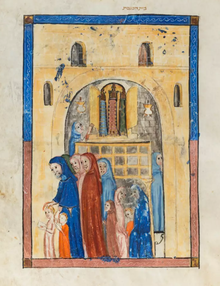
Jews of Catalonia (Catalonian Jewry, Catalonian Judaism, in Hebrew: יהדות קטלוניה) is the Jewish community that lived in the Iberian Peninsula, in the Lands of Catalonia, Valencia and Mallorca[1] until the expulsion of 1492. Its splendor was between the 12th to 14th centuries, in which two important Torah centers flourished in Barcelona and Girona. The Catalan Jewish community developed unique characteristics, which included customs, a prayer rite (Nusach Catalonia),[2] and a tradition of its own in issuing legal decisions (Halakhah).[3] Although the Jews of Catalonia had a ritual of prayer[4] and different traditions from those of Sepharad[5], today they are usually included in the Sephardic Jewish community.
Following the expulsion of 1492, Jews who did not convert to Christianity were forced to emigrate to Italy, the Ottoman Empire, the Maghreb, North Africa and the Middle East.[6][7][8]
- ^ See: Yitzhak Baer, A history of the Jews in Christian Spain, Philadelphia : Jewish Publication Society of America, 1961-1966.
- ^ According to Rabbi Yitzhaq Luria Ashkenazi (Arizal), nusach Catalonia is one of the 12 existing nusachim that correspond to the 12 tribes of Israel (Rabbi Chayim Vital, Sefer Shaar ha-Kavanot, nusach ha-tefillah, the secret of the 12 doors). Regarding the different traditions and customs, the Arizal divides the people of Israel into four major families: Sepharad, Ashkenaz, Catalonia and Italy (Sheneh Luchot ha-Berit, Torah she-bikhtav, Bemidbar).
- ^ Rabbi Shimon ben Tzemach Duran (Rashbatz) mentions on several occasions that in Catalonia tradition was ruled according to the opinions of Rabbi Shelomoh ben Adret (Rashba) while in Sepharad was ruled according to the opinions of Rabbi Asher ben Yechiel (Rosh), Rabbi Yaaqov ben Asher (Baal ha-Turim) and Rabbi Moshe ben Maymon (Rambam): «In Catalonia the halachic decisions are followed according to Rashba, while in Sepharad are followed according to Baal ha-Turim and Rambam» (reference: Tashbetz, vol 3, 257, see also: Tashbetz vol 2, 141, vol 3, 86, vol 3, 118, vol 4, column 3, 10).
- ^ Recently, has been published the Sidur Catalunya, which constitutes the first reconstruction of the old nusach Catalonia. The siddur is based on six medieval Hebrew manuscripts (from the 14th to the 16th century) and also includes a series of commentaries, laws and customs compiled by a disciple of Rabbi Yona Girondi at the Talmudic academy of Barcelona.
- ^ In the halakhic and Responsa literature of the Rishonim, a clear distinction between Sepharad and Catalonia is made, both in customs and rites of prayer. See: Responsa of Rabbi Avraham ben David (Raabad) 131, Responsa of Rabbi Shelomoh ben Adret (Rashba) new 345, Responsa of Rabbi Yitzchaq bar Sheshet (Ribash), 79, 369. Responsa of Rabbi Shimon ben Tzemach Duran (Rashbatz), Tashbetz vol. 3, 118; vol. 4 (Chut ha-Meshulash), column 3, 10; vol 3, 257; vol. 2, 141, vol. 3, 86, vol. 3, 118, vol. 4, column 3, 10. For more information about the differences between the customs of Catalonia and Sepharad see: Aharon Gabbai, «Hanachat Tefillin be-chol ha-moed». Haotzar 16 (5778), pp. 366-379 (in Hebrew). Aharon Gabbai, «Nusach chatimat birkat ha-erusin», Moriah year 36, 1-2 (5778), pp. 349-369 (in Hebrew).
- ^ Ray, Jonathan (2013). After Expulsion: 1492 and the Making of Sephardic Jewry. NYU Press. ISBN 9780814729113.
- ^ "Ottoman Empire welcomed Jews exiled from Spain".
- ^ "Spain announces it will expel all Jews".
